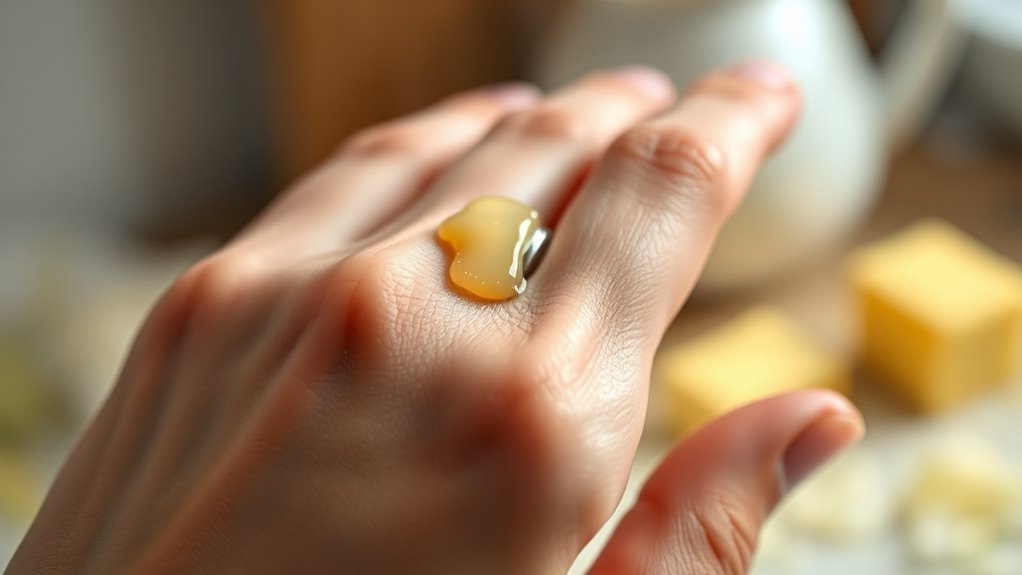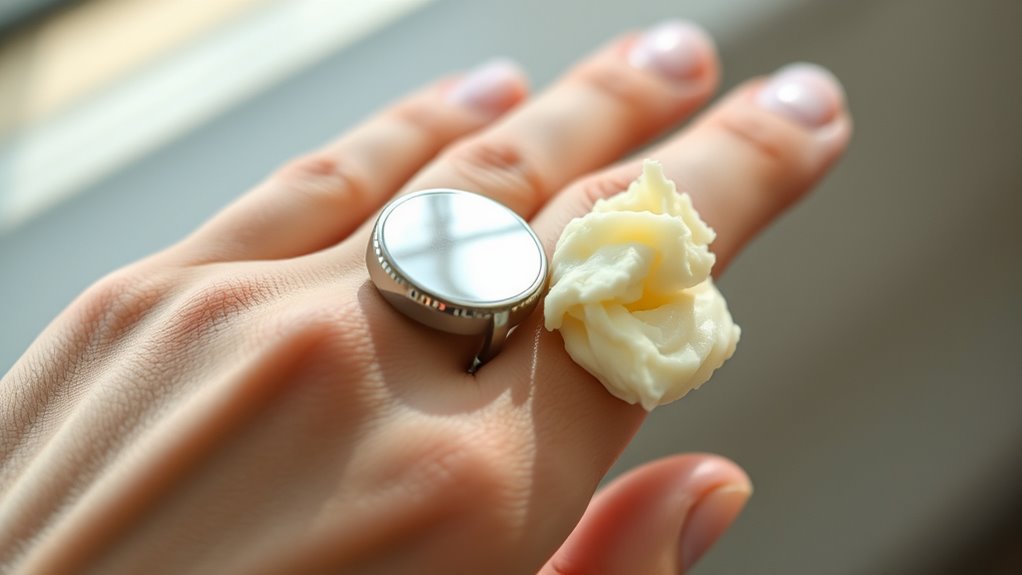Using butter to remove a stuck ring is effective, but you should take precautions. Always use unsalted butter to avoid skin irritation. Apply a generous amount around the ring and your finger, massaging it in gently. Twist the ring back and forth without forcing it. If it doesn’t budge, reapply butter or wait a minute before trying again. Monitor for swelling or discomfort, and if issues arise, seek professional help. There’s more you can learn about safe removal techniques.
Key Takeaways
- Always use unsalted butter to prevent potential skin irritation during the removal process.
- Generously apply butter around the ring and finger, ensuring all areas are covered for effective lubrication.
- Gently twist the ring back and forth; avoid yanking to reduce the risk of injury to your finger.
- Monitor your finger for swelling or discomfort, and seek professional assistance if significant issues arise.
- After removal, check for skin irritation and avoid repeating unsafe methods in the future.

If you’ve ever found yourself in a panic because a ring won’t budge from your finger, you’re not alone. Many people experience this frustrating situation, especially if a ring’s been on for a while or if your fingers swell due to heat or other factors. While some may suggest dramatic measures like cutting the ring off, there are safer and more effective ring removal techniques you can try first. Butter, surprisingly, is one of those household alternatives that can help you slip that stubborn ring off with ease.
To start, gather some unsalted butter from your kitchen. It’s important to use unsalted butter, as salt can irritate your skin and make the situation worse. Once you’ve got your butter, apply a generous amount around the ring and on the finger itself. The idea is to create a slippery surface that allows the ring to slide off more easily. Massage it gently into your skin, and don’t be shy about using your other hand to help. You’ll want to ensure the butter gets into every crevice for the best results.
Gather unsalted butter, apply generously around the ring and finger, and massage gently to create a slippery surface for easier removal.
After you’ve applied the butter, try gently twisting the ring back and forth while pulling it off. Don’t yank it or force it, as that can lead to injury. If the butter isn’t working immediately, give it a minute or two. Sometimes, the added lubricant takes a little time to do its thing. If needed, you can reapply more butter and continue the process. Additionally, using crochet tools can enhance your dexterity and make the process smoother.
If butter doesn’t do the trick, there are other household alternatives you can explore. For example, using soap and water can also provide that much-needed slip. Simply lather up your finger and the ring with dish soap, and then try to wiggle the ring off. Another option is to try dental floss or a piece of string. Slide it under the ring and wrap it around your finger, then slowly unwind the floss while pulling gently on the ring.
While these ring removal techniques can be effective, it’s always wise to keep an eye on your finger for signs of swelling or discomfort. If you notice any unusual changes, it might be best to seek professional help. Remember, the goal is to remove the ring safely and without causing injury. By using butter or other household alternatives, you can hopefully resolve the situation quickly and keep your finger safe.
Frequently Asked Questions
Can I Use Other Oils Instead of Butter?
Yes, you can use alternative oils instead of butter to help with stuck rings. Natural remedies like olive oil, coconut oil, or vegetable oil can effectively lubricate your finger, making it easier to slide the ring off. Just apply a small amount of your chosen oil around the ring and gently twist it. Remember, if it doesn’t work right away, don’t force it—patience is key with these natural solutions!
What if the Ring Is Too Tight to Move?
If the ring’s too tight to move, try a few ring removal techniques. Start with soap and water or a lubricant to ease it off. If that doesn’t work, elevate your hand above your heart for a few minutes to reduce swelling. If you’re still struggling, don’t hesitate to seek medical consultation. A professional can safely remove the ring without causing injury. Your comfort and safety should always come first!
Is There a Risk of Allergic Reactions to Butter?
Yes, there’s a risk of allergic reactions to butter, especially if you have skin sensitivities or allergenic concerns. Think of it like trying on a new pair of shoes; they might feel fine at first, but they could cause blisters later. If you’re unsure about your reaction to butter, it’s best to test a small area first. Always listen to your body and opt for alternatives if you’re worried about irritation.
How Do I Clean My Ring After Using Butter?
To clean your ring after using butter, start by rinsing it under warm water to remove any ring residue. Next, use a gentle dish soap on a soft cloth or toothbrush to scrub the ring lightly. Rinse it again to make sure all soap is gone. For extra shine, dry it with a clean, soft cloth. These cleaning methods will keep your ring looking great and free from any greasy remnants.
Can Butter Damage Certain Types of Metals or Stones?
Yes, butter can damage certain types of metals and stones. When you apply butter, it might lead to metal corrosion, especially with softer metals like silver or brass. Additionally, if your ring has gemstones, the oils from the butter can cause gemstone damage, dulling their luster or affecting their setting. To avoid these issues, it’s best to clean your ring thoroughly after using butter to protect its integrity and shine.
Conclusion
So, the next time a ring decides to play hard to get, don’t panic! Just grab some butter and let it work its magic like a tiny, golden superhero. In just a few moments, you’ll be free and feeling fabulous, ready to flaunt your fingers like they’re on a runway. Remember, butter’s not just for toast; it’s your secret weapon against stubborn jewelry! Embrace the buttery bliss and save your day—who knew liberation could be so delicious?









